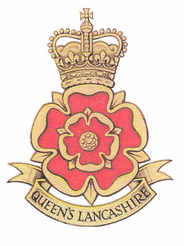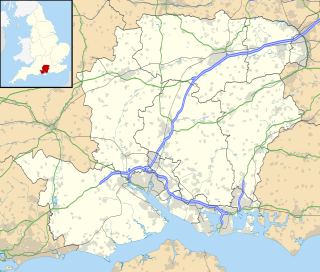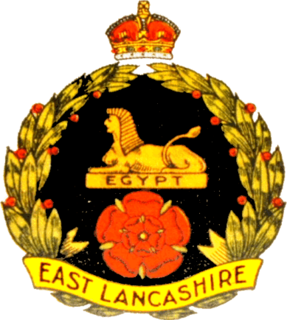
The French Imperial Eagle refers to the figure of an eagle on a staff carried into battle as a standard by the Grande Armée of Napoléon I during the Napoleonic Wars.

The Queen's Lancashire Regiment (QLR) was an infantry regiment of the British Army, part of the King's Division. It was formed on 25 March 1970 at Connaught Barracks in Dover through the amalgamation of the two remaining Lancashire infantry regiments, the Lancashire Regiment and the Loyal Regiment. In July 2006 the regiment was amalgamated with two other Northern infantry regiments to form the Duke of Lancaster's Regiment.
The 47th (Lancashire) Regiment of Foot was an infantry regiment of the British Army, raised in Scotland in 1741. It served in North America during the Seven Years' War and American Revolutionary War and also fought during the Napoleonic Wars and the Crimean War. Under the Childers Reforms it amalgamated with the 81st Regiment of Foot to form the Loyal Regiment in 1881.
North-West Europe campaign of 1940 is a battle honour given to several regiments in the British Army. It refers to the land campaign starting with the invasion of France in May 1940, and ending with the evacuation of the British Expeditionary Force from Dunkirk and other ports.

The Duke of Lancaster's Regiment (LANCS) is an infantry regiment of the line within the British Army, part of the King's Division. Headquartered in Preston, it recruits throughout the North West of England.

The South Lancashire Regiment was a line infantry regiment of the British Army in existence from 1881 to 1958.

The King's Own Royal Border Regiment was an infantry regiment of the British Army in existence from 1959 until 2006, and was part of the King's Division. It was formed at Barnard Castle on 1 October 1959 through the amalgamation of the King's Own Royal Regiment (Lancaster) and the Border Regiment. The official abbreviated form of the regimental title was 'KING'S OWN BORDER'.

The Royal Green Jackets (Rifles) Museum is situated at Peninsula Barracks in Winchester, England. The museum is one of several regimental museums that form part of Winchester's Military Museums.
The South Essex Regiment, later the Prince of Wales' Own Volunteers, is a fictional infantry line regiment in the British Army that was created by Bernard Cornwell in the Sharpe series of books.

The King's Division is a British Army command, training and administrative apparatus designated for infantry regiments in the North of England.

The York and Lancaster Regiment was a line infantry regiment of the British Army that existed from 1881 until 1968. The regiment was created in the Childers Reforms of 1881 by the amalgamation of the 65th Regiment of Foot and the 84th Regiment of Foot. The regiment saw service in many small conflicts and both World War I and World War II until 1968, when the regiment chose to be disbanded rather than amalgamated with another regiment, one of only two infantry regiments in the British Army to do so, with the other being the Cameronians.

The 42nd Infantry Brigade, also known as 42 Brigade, was a brigade of the British Army.

The East Lancashire Regiment was, from 1881 to 1958, a line infantry regiment of the British Army. The regiment was formed in 1881 under the Childers Reforms by the amalgamation of the 30th (Cambridgeshire) Regiment of Foot and 59th Regiment of Foot with the militia and rifle volunteer units of eastern Lancashire. In 1958 the regiment was amalgamated with the South Lancashire Regiment to form the Lancashire Regiment which was, in 1970, merged with the Loyal Regiment to form the Queen's Lancashire Regiment. In 2006, the Queen's Lancashire was further amalgamated with the King's Own Royal Border Regiment and the King's Regiment to form the present Duke of Lancaster's Regiment.

The King's Own Royal Regiment (Lancaster) was a line infantry regiment of the British Army. It served under various titles and fought in many wars and conflicts, including both World War I and World War II, from 1680 to 1959. In 1959, the regiment was amalgamated with the Border Regiment to form the King's Own Royal Border Regiment.

The Loyal Regiment was a line infantry regiment of the British Army that was in existence from 1881 to 1970. In 1970, the regiment was amalgamated with the Lancashire Regiment to form the Queen's Lancashire Regiment which was, in 2006, amalgamated with the King's Own Royal Border Regiment and the King's Regiment to form the Duke of Lancaster Regiment.

The Duke of Cornwall's Light Infantry (DCLI) was a light infantry regiment of the British Army in existence from 1881 to 1959.
In countries whose armies are organised on a regimental basis, such as the army of the United Kingdom, a regimental museum is a military museum dedicated to the history of a specific army regiment.

The Duke of Lancaster's Own Yeomanry was a British Army regiment that existed from 1798 to 1992. The regiment sent mounted infantry for service in the Second Boer War as the Imperial Yeomanry, between 1900 and 1902, and also saw action during the First and Second World Wars. Its lineage is maintained by B Squadron, the Queen's Own Yeomanry.

Headquarters North West formally known as 42nd Infantry Brigade and Headquarters North West is a regional command based in North West England. The command administers the reserve units based in its area and also provides the military support HQ for the police and civilian population in the area. In 2017, 42 Infantry Brigade was reduced to Headquarters North West.
















